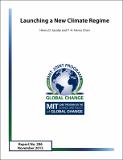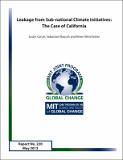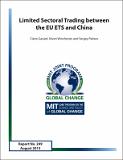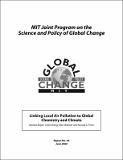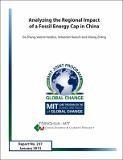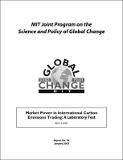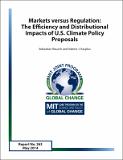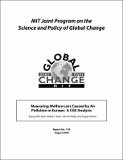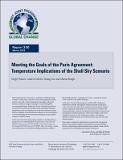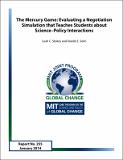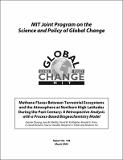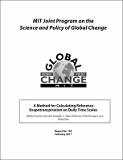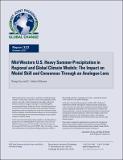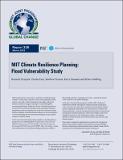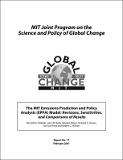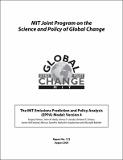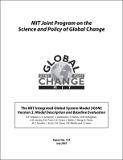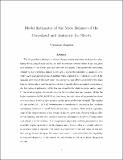Browsing Center for Global Change Science by Title
Now showing items 202-221 of 337
-
Launching a New Climate Regime
(MIT Joint Program on the Science and Policy of Global Change, 2015-11)At the 2015 UN Framework Convention on Climate Change (UNFCCC) meeting in Paris, participants in a new international climate agreement will volunteer Nationally Determined Contributions to emissions reductions. To put the ... -
Leackage from Sub-national Climate Initiatives: The Case of California
(MIT Joint Program on the Science and Policy of Global Change, 2012-05-29)With federal policies to curb greenhouse gas emissions in the U.S. stagnating, California has taken action on its own. We estimate the impact of California’s cap-and-trade program on the leakage of emissions to other ... -
Limited Sectoral Trading between the EU ETS and China
(MIT Joint Program, 2013-08-21)In the negotiations of the United Nations Framework Convention on Climate Change (UNFCCC), new market mechanisms are proposed to involve Non-Annex I countries in the carbon markets developed by Annex I countries, beyond ... -
Linking local air pollution to global chemistry and climate
(MIT Joint Program on the Science and Policy of Global Change, 2000-06)We have incorporated a reduced-form urban air chemistry model in MIT's 2D-LO coupled chemistry-climate model. The computationally efficient reduced-form urban model is derived from the California Institute of Technology-Carnegie ... -
Marginal Abatement Costs and Marginal Welfare Costs for Greenhouse Gas Emissions Reductions: Results from the EPPA Model
(MIT Joint Program on the Science and Policy of Global Change, 2008-11)Marginal abatement cost (MAC) curves, relationships between tons of emissions abated and the CO2 (or GHG) price, have been widely used as pedagogic devices to illustrate simple economic concepts such as the benefits of ... -
Market Cost of Renewable Jet Fuel Adoption in the United States
(MIT Joint Program on the Science and Policy of Global Change, 2013-01)The US Federal Aviation Administration (FAA) has a goal that one billion gallons of renewable jet fuel is consumed by the US aviation industry each year from 2018. We examine the cost to US airlines of meeting this goal ... -
Market power in international carbon emissions trading: a laboratory test
(2003-01)The prospect that governments of one or a few large countries, or trading blocs, would engage in international greenhouse gas emissions trading has led several policy analysts to express concerns that trade would be ... -
Markets versus Regulation: The Efficiency and Distributional Impacts of U.S. Climate Policy Proposals
(MIT Joint Program on the Science and Policy of Global Change, 2014-05)Regulatory measures have proven the favored approach to climate change mitigation in the U.S., while market-based policies have gained little traction. Using a model that resolves the U.S. economy by region, income category, ... -
Measuring Welfare Loss Caused by Air Pollution in Europe: A CGE Analysis
(MIT Joint Program on the Science and Policy of Global Change, 2009-08)To evaluate the socio-economic impacts of air pollution, we develop an integrated approach based on computable general equilibrium (CGE). Applying our approach to Europe shows that even there, where air quality is relatively ... -
Meeting the Goals of the Paris Agreement: Temperature Implications of the Shell Sky Scenario
(MIT Joint Program on the Science and Policy of Global Change, 2018-04)The Paris Agreement makes long-term energy and climate projections particularly important because it calls for a goal that likely requires an energy system that is based on a radically different fuel mix than currently in ... -
The Mercury Game: Evaluating a Negotiation Simulation that Teaches Students about Science–Policy Interactions
(MIT Joint Program on the Science and Policy of Global Change, 2014-01)Environmental negotiations and policy decisions take place at the science–policy interface. While this is well known in academic literature, it is often difficult to convey how science and policy interact to students in ... -
Methane Fluxes Between Terrestrial Ecosystems and the Atmosphere at Northern High Latitudes During the Past Century: A retrospective analysis with a process-based biogeochemistry model
(MIT Joint Program on the Science and Policy of Global Change, 2004-03)We develop and use a new version of the Terrestrial Ecosystem Model (TEM) to study how rates of methane (CH4) emissions and consumption in high-latitude soils of the Northern Hemisphere have changed over the past century ... -
A Method for Calculating Reference Evapotranspiration on Daily Time Scales
(MIT Joint Program on the Science and Policy of Global Change, 2011-02)Measures of reference evapotranspiration are essential for applications of agricultural management and water resources engineering. Using numerous esoteric variables, one can calculate daily reference evapotranspiration ... -
Mid-Western U.S. Heavy Summer-Precipitation in Regional and Global Climate Models: The Impact on Model Skill and Consensus Through an Analogue Lens
(MIT Joint Program on the Science and Policy of Global Change, 2017-10)Regional climate models (RCMs) in general can simulate the characteristics of heavy/extreme precipitation more accurately than general circulation models (GCMs) as a result of more realistic representation of topography ... -
MIT Climate Resilience Planning: Flood Vulnerability Study
(MIT Joint Program on the Science and Policy of Global Change, 2018-03)The MIT Flood Vulnerability Study is one key part of a broader initiative led by the MIT Climate Resiliency Committee (CRC) and the MIT Office of Sustainability (MITOS) to understand and recommend how MIT can continue to ... -
The MIT Emissions Prediction and Policy Analysis (EPPA) model : revisions, sensitivities, and comparisons of results
(MIT Joint Program on the Science and Policy of Global Change, 2001-02)The Emissions Prediction and Policy Analysis (EPPA) model is a component of the MIT Integrated Earth Systems Model (IGSM). Here, we provide an overview of the model accessible to a broad audience and present the detailed ... -
The MIT Emissions Prediction and Policy Analysis (EPPA) Model: Version 4
(MIT Joint Program on the Science and Policy of Global Change, 2005-08)The Emissions Prediction and Policy Analysis (EPPA) model is the part of the MIT Integrated Global Systems Model (IGSM) that represents the human systems. EPPA is a recursive-dynamic multi-regional general equilibrium model ... -
The MIT EPPA6 Model: Economic Growth, Energy Use, and Food Consumption
(MIT Joint Program on the Science and Policy of Global Change, 2015-03)The MIT Economic Projection and Policy Analysis (EPPA) model has been broadly applied on energy and climate policy analyses. In this paper, we provide an updated version of the model based on the most recent global economic ... -
MIT Integrated Global System Model (IGSM) Version 2: Model Description and Baseline Evaluation
(MIT Joint Program on the Science and Policy of Global Change, 2005-07)The MIT Integrated Global System Model (IGSM) is designed for analyzing the global environmental changes that may result from anthropogenic causes, quantifying the uncertainties associated with the projected changes, and ... -
Model estimates of the mass balance of the Greenland and Antartic ice sheets
(MIT Joint Program on the Science and Policy of Global Change, 1999-10)The six possible combinations of two climate models and three methods for calculating the melting of snow and ice are used to estimate current values of accumulation and ablation on the Greenland and Antarctic ice sheets. ...

